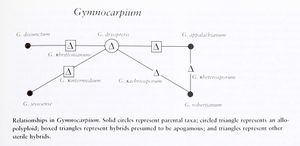Difference between revisions of "Gymnocarpium"
Phytologist 4: 371. 1851.
FNA>Volume Importer |
imported>Volume Importer |
||
| (One intermediate revision by the same user not shown) | |||
| Line 110: | Line 110: | ||
|publication year=1851 | |publication year=1851 | ||
|special status= | |special status= | ||
| − | |source xml=https:// | + | |source xml=https://bitbucket.org/aafc-mbb/fna-data-curation/src/2e0870ddd59836b60bcf96646a41e87ea5a5943a/coarse_grained_fna_xml/V2/V2_75.xml |
|genus=Gymnocarpium | |genus=Gymnocarpium | ||
}}<!-- | }}<!-- | ||
-->[[Category:Treatment]][[Category:Dryopteridaceae]] | -->[[Category:Treatment]][[Category:Dryopteridaceae]] | ||
Latest revision as of 20:25, 5 November 2020
Plants terrestrial. Stems long-creeping, stolons absent. Leaves monomorphic, dying back in winter. Petiole ca. 1.5–3 times length of blade, base not swollen; vascular bundles 2, lateral, ± oblong in cross section. Blade broadly deltate, ternate, or ovate, 2–3-pinnate-pinnatifid, reduced distally to pinnatifid apex, herbaceous. Pinnae weakly articulate to rachis but persistent, segment margins entire to crenate; proximal pinnae longest, petiolulate, usually ± inequilateral with pinnules on basiscopic side longer than those on acroscopic side; costae adaxially grooved, grooves not continuous from rachis to costae; indument lacking or of minute (0.1 mm) glands abaxially and sometimes along costae adaxially. Veins free, simple or forked. Sori in 1 row between midrib and margin, ± round; indusia absent. Spores brownish, rugose. x = 40.
Distribution
North temperate regions, North America, Eurasia.
Discussion
Species 8 (5 in the flora).
Selected References
Lower Taxa
Key
| 1 | Adaxial blade surface glabrous or moderately glandular, abaxial blade surface and rachis moderately or densely glandular. | > 2 |
| 1 | Adaxial and abaxial blade surfaces and rachis essentially glabrous. | > 3 |
| 2 | Blades glabrous on adaxial surface; proximal pinnae and basiscopic pinnules of proximal pinnae curving toward apex of leaf and apex of pinna, respectively; pinnae of 2d pair almost always sessile with basal pinnules ± equal in length to adjacent pinnules. | Gymnocarpium jessoense subsp. parvulum |
| 2 | Blades moderately glandular on adaxial surface; proximal pinnae and basiscopic pinnules of proximal pinnae ± perpendicular to rachis and costa, respectively; pinnae of 2d pair usually stalked, or if sessile with basal pinnules shorter than adjacent pinnules. | Gymnocarpium robertianum |
| 3 | Pinnae of 2d pair and basal basiscopic pinnule of proximal pinnae stalked. | Gymnocarpium appalachianum |
| 3 | Pinnae of 2d pair sessile or rarely stalked; proximal basiscopic pinnule of basal pinnae sessile. | > 4 |
| 4 | Pinnae of 2d pair sessile with basal pinnules unequal in length (basiscopic markedly longer); ultimate segments of proximal pinnae slightly lobed to crenate, apex often crenulate, acute; blades 8-24 cm. | Gymnocarpium disjunctum |
| 4 | Pinnae of 2d pair rarely stalked, if sessile with basal pinnules ± equal in length (basiscopic = acroscopic); ultimate segments of proximal pinnae crenate to entire, apex entire, rounded; blades 3-14 cm. | > 5 |
| 5 | Sessile basal basiscopic pinnule of proximal pinnae with basal basiscopic pinnulet (division of pinnule) ± equal in length to adjacent pinnulet; pinnae of 2d pair usually sessile, with basal pinnules ± equal in length to adjacent basal pinnule; spores 34-39 µm. | Gymnocarpium dryopteris |
| 5 | Sessile basal basiscopic pinnule of proximal pinnae with basal basiscopic pinnulet shorter than adjacent pinnulet; pinnae of 2d pair sessile, with basal pinnules shorter than adjacent pinnule, or 2d basal pinnae rarely stalked; spores 27-31 µm. | Gymnocarpium appalachianum |
